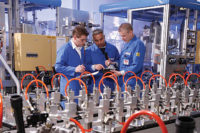Army Trail Road, in Chicago’s western suburbs, is dotted with metal fabrication plants — production facilities offering high-tech manufacturing jobs at living wages.
Problem is, like the other manufacturing centers of the U.S., employers can’t find the skilled workers to fill the positions, and young people looking for work often don’t know the jobs exist.
“Nobody knows about the opportunity, no one,” says Joe Dutra, lead coordinator for Career Connect West in suburban Chicago’s DuPage County. “I think that’s the single best thing that we could do now in order to help the manufacturing industry with their staffing crises, is just getting the word out that it’s there. Once people hear about the opportunity to work on creating precise items for important machinery for things like health care and aerospace, all of a sudden manufacturing goes from working in a coal mine or working in a foundry to creating important tools that build our society.”
The “skills gap” in Chicagoland is emblematic of a national trend that will see more than half of 3.5 million manufacturing job openings go unfilled over the next decade, according to the Manufacturing Institute’s 2015 Skills Gap report. The gap grows, the report says, as baby boomers retire, and as industry continues to recover from mid-2000s job losses. Those realities are compounded by a negative image of manufacturing among young people, as well as lagging science, technology, engineering and mathematics (STEM) education and the decline of technical training, according to the report.
“Over the bulk of the 2000s there was a lot of job loss in manufacturing,” explains Gardner Carrick, vice president of strategic initiatives for The Manufacturing Institute. “So people are concerned about choosing a career in an industry or for positions that they think might not be there. No one wants to get laid off. But that’s something that has changed in the last five or six years as we’ve seen a pretty strong resurgence in manufacturing hiring and manufacturing job growth in the US. All trends seem to point to that continuing.”
Manufacturers will always find a way to keep producing, he says, through increased efficiencies and technology, but every unfilled job stifles potential growth.
“If you can’t take on new orders, you can’t expand your business,” Carrick continues. “You can’t expand exports if you can’t fill the positions that are needed to create goods.
“The problem to the greater economy is that manufacturers are a really important factor in economic growth. So if you have a restricted manufacturing sector because of the skills gap, then you probably have restricted economic growth overall. Manufacturing jobs pay better than your average service jobs, especially for that skill level. So you’re going to have less purchasing power, and less movement into the upper and middle class if you don’t have people fulfilling high five-figure jobs in manufacturing.”
To combat the gap, programs like Career Connect West, which recruits workers for accelerated training and job placement in manufacturing careers, is being joined by similar programs sprouting up around the country. At nearby Harper College, The Fabricators & Manufacturers Association donated $500,000 towards a new, $1.5 million facility designed to create needed skilled workers. And in Emporia, Va., the Commonwealth Center for Advanced Manufacturing launched an advanced manufacturing program to train active duty soldiers preparing for civilian life and veterans who recently transitioned to civilian life — a model they hope expands to training centers near military bases nationwide.
All of these programs are geared towards quickly training and accrediting mid-skilled workers. CCAM’s transitioning military program just completed its pilot program in August. It takes a little more than five months to complete the training program, compared to more than two years for a traditional technical program. The instruction is split between two months of online learning and then three months of hands-on training. At the conclusion, the newly minted workers in the CNC Machine cohort will earn 4 NIMS certifications, and the industrial maintenance cohort will earn Siemens Mechatronics certifications.
Those workers can go on to expect healthy employment in Virginia’s robust manufacturing economy that employs 30,500 workers in the aerospace industry, 16,000 in automotive, 34,000 in food processing and 19,000 in plastics, according to CCAM Director of Workforce Development Bruce Sobczak.
Still, despite the numbers of quality employers looking for mid-skilled workers, the word is not getting out.
“That mid-skill label can be deceiving,” Sobczak says. “Many of these jobs pay more than jobs requiring a four-year degree. In some cases you can make six figures. That demand is really there.”
Like Dutra, Sobczak points to the public perception issue.
“Everybody pictures the dirty smoke stacks,” he says. “It’s really quite different now. Some of the plants that we deal with … I think you could eat off the floors there. They’re very organized, clean environments, safe environments, very high-tech environments.
“Reaching people in this day and age is quite a challenge for manufacturers. They’re not used to the social media and the ways that Millennials interact. So we are working hard to reach out to youth in many ways.”
The negative perception starts early with what he describes as the “not my kid syndrome.”
“Some parents don’t want [their children] to consider manufacturing jobs necessarily and see going into a trade as settling for something other than they could have with a four-year degree,” he explains.
“And it couldn’t be more the opposite. So educating the parents, too, is tough. And you name it, the whole ecosystem of counselors and everybody needs to be brought up to speed.”
The gap isn’t just limited to the mid-skill production workers. Of the 3.5 million manufacturing jobs that will need to be filled this decade, a sizeable percentage will be for engineers and others with college and advanced degrees in STEM fields. Again, the problem might be one of perception. When young and promising computer scientists graduate, their first thought is often the dot-coms in Silicon Valley, not the high-tech jobs offered by manufacturers.
“Companies need to have a really smart talent strategy to really beat out the competition from the high tech companies out there like Google and Facebook,” says Matt Doan, Booz Allen Hamilton, senior associate in the commercial solutions group. “Different manufacturing organizations really need to be bold and build a culture that celebrates forward thinking and fosters employee engagement. Really recasting the view of a blue-collar environment and making it feel like a cutting edge place to have a career.”
Manufacturers are working to change the perception, with programs like Career Connect, or the regular visits to high schools made by industry leaders like Sobczak, as well events like Manufacturing Day.
On Manufacturing Day, the first Friday in October, companies open their doors and invite the community to tour their facilities.
“Most manufacturing plants are 100 yards off the road with no windows,” Carrick says. “So you really have no idea what’s happening in those buildings. So let’s demystify it, and show them the cool products we’re making and the cool machines we’re using to make those products.”




